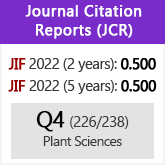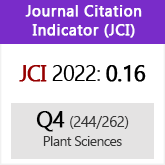First record of Caulerpa cylindracea (Caulerpaceae, Chlorophyta) in Andalusia (Southern Spain)
DOI:
https://doi.org/10.3989/ajbm.2381Keywords:
ITS sequence, maërl, Mediterranean Sea, Caulerpa cylindracea, phylogenetic analysisAbstract
Three different species of Caulerpa (Caulerpaceae, Chlorophyta) co-occur in the Mediterranean Sea: two of them are found at the central-eastern basin and are typically considered non aggressive components of the Lessepsian flora [(C. chemnitzia(Esper) J.V. Lamouroux and C. racemosa var. lamourouxii (Turner) Weber-van Bosse f. requienii(Montagne) Weber van Bosse)]; a third taxon, C. cylindracea Sonder has aggressively expanded its range since its first observation in 1990, and it is nowadays reported from nearly all the Mediterranean countries. We report a population of C. cylindracea from Almería (Andalusia, Southern Iberian Peninsula) at −30 m depth as to be the westernmost record of the invasive variety on the Mediterranean European coast. Therefore, we made use of morphological description and molecular phylogenetics to provide a complete identification of this invasive seaweed in Southern Spain. Our findings are discussed in light of the composition of the receptor communities, such as maërl bed, edges of Posidonia oceanica (Linnaeus) Delile, and their ecology. Our results confirmed the suggested directionality of the invasive pathway to be westward to the Strait of Gibraltar, mainly supported by sea currents and vectors of anthropogenic origin.
Downloads
References
Andreakis, N., Procaccini, G. & Kooistra, W.H.C.F. 2004. Asparagopsis taxiformis and Asparagopsis armata (Bonnemaisoniales, Rhodophyta): genetic and morphological identification of Mediterranean populations. European Journal of Phycology 39: 273-283. http://dx.doi.org/10.1080/0967026042000236436
Bandelt, H.J., Forster, P. & Röhl, A. 1999. Median-joining networks for inferring intraspecific phylogenies. Molecular Biology and Evolution 16: 37-48. http://dx.doi.org/10.1093/oxfordjournals.molbev.a026036 PMid:10331250
Belton G.S., Prud'homme van Reine W.F., Huisman J.M., Draisma S.G.A. & Gurgel C.F.D. 2014. Resolving phenotypic plasticity and species designation in the morphologically challenging Caulerpa racemosa–peltata complex (Chlorophyta, Caulerpaceae). Journal of Phycology. http://dx.doi.org/10.1111/jpy.12132
Bentaallah M. El A. & Kerfouf A. 2013. Prolifération de l'algue Caulerpa racemosa dans les écosystèmes littoraux de l'Algérie: état des lieux et des connaissances. Physio-Géo - Géographie Physique et Environnement, volume VII, supplément: 61-68.
Borchsenius F. 2009. FastGap 1.2. Department of Biosciences, Aarhus University, Denmark. Published online at http://www.aubot.dk/FastGap_home.htm
Boudouresque, C.F. & Verlaque, M. 2002. Biological pollution in the Mediterranean Sea: invasive versus introduced macrophytes. Marine Pollution Bulletin 44: 32-38. http://dx.doi.org/10.1016/S0025-326X(01)00150-3
Bouiadjra, B.B., Taleb, M.Z., Marouf, A., Benkada, M.Y. & Riadi, H. 2010. First record of the invasive alga Caulerpa racemosa (Caulerpales, Chlorophyta) in the Gulf of Arzew (western Algeria). Aquatic Invasions 5: 97-101. http://dx.doi.org/10.3391/ai.2010.5.S1.020
Cebrián, E. & Ballesteros, E. 2009. Temporal and spatial variability in shallow-and deep-water populations of the invasive Caulerpa racemosa var. cylindracea in the Western Mediterranean. Estuarine, Coastal and Shelf Science 83: 469-474. http://dx.doi.org/10.1016/j.ecss.2009.04.026
Darriba, D., Taboada, G.L., Doallo, R. & Posada, D. (2012) jModelTest 2: more models, new heuristics and parallel computing. Nature methods 9, 772-772. http://dx.doi.org/10.1038/nmeth.2109 PMid:22847109 PMCid:PMC4594756
Durand, C., Manuel, M., Boudouresque, C.F., Meinesz, A., Verlaque, M. & Le Parco, Y. 2002. Molecular data suggest a hybrid origin for the invasive Caulerpa racemosa (Caulerpales, Chlorophyta) in the Mediterranean Sea. Journal of Evolutionary Biology 15: 122-133. http://dx.doi.org/10.1046/j.1420-9101.2002.00370.x
European Environmental Agency. 2007. Halting the loss of biodiversity by 2010: proposal for a first set of indicators to monitor progress in Europe EEA. Technical report No 11/2007
Famà, P., Olsen, J.L., Stam, W.T. & Procaccini, G. 2000. High levels of intra- and inter-individual polymorphism in the rDNA ITS1 of Caulerpa racemosa (Chlorophyta). European Journal of Phycology 35: 349-356. http://dx.doi.org/10.1080/09670260010001735951
Flagella, M.M., Lorenti, M. & Buia, M.C. 2008. Temperature response in a shallow-water Mediterranean population of Caulerpa racemosa var. cylindracea (Caulerpales, Chlorophyta), and a possible strategy of season anticipation. Botanica Marina 51: 278-284. http://dx.doi.org/10.1515/BOT.2008.037
Guillén, J., Jiménez, S., Martinez, J., Triviño, A., Múgica, Y., Argilés, J. & Bueno, M. 2010. Expansion of the invasive algae Caulerpa racemosa var. cylindracea (Sonder) Verlaque, Huisman & Boudouresque, 2003 on the region of Valencia seabed. Thalassas 26: 135-149.
Hall, T. 1999. BioEdit: a user-friendly biological sequence alignment editor and analysis program for Windows 95/98/NT. Nucleic Acids Symposium Series 41: 95-98.
Huelsenbeck, J.P. & Ronquist, F. 2001. MRBAYES: Bayesian inference of phylogenetic trees. Bioinformatics 17: 754-755. http://dx.doi.org/10.1093/bioinformatics/17.8.754 PMid:11524383
Kapraun, D.F. 2005. Nuclear DNA content estimates in multicellular green, red and brown algae: phylogenetic considerations. Annals of Botany 95: 7-44. http://dx.doi.org/10.1093/aob/mci002 PMid:15596456 PMCid:PMC4246707
Klein, J. & Verlaque, M. 2008. The Caulerpa racemosa invasion: A critical review. Marine Pollution Bulletin 56: 205-225. http://dx.doi.org/10.1016/j.marpolbul.2007.09.043 PMid:18061625
Nizamuddin, M. 1991. The Green Marine Algae of Libya. Elga Publishers, Bern, Switzerland.
Nuber, N., Gornik, O., Lauc, G., Bauer, N., Zuljevic, A., Papes, D. & Zoldos, V. 2007. Genetic evidence for the identity of Caulerpa racemosa (Forsskål) J. Agardh (Caulerpales, Chlorophyta) in the Adriatic Sea. European Journal of Phycology 42: 113-120. http://dx.doi.org/10.1080/09670260600933774
Olsen, J.L., Valero, M., Meusnier, I., Boele-Bos, S. & Stam, W.T. 1998. Mediterranean Caulerpa taxifolia and C. mexicana (Chlorophyta) are not conspecific. Journal of Phycology 34: 850-856. http://dx.doi.org/10.1046/j.1529-8817.1998.340850.x
Rivera-Ingraham, G.A., García-Gómez, J.C. & Espinosa, F. 2010. Presence of Caulerpa racemosa (Forsskal) J. Agardh in Ceuta (Northern Africa, Gibraltar Area). Biological Invasions 12: 1465-1466. http://dx.doi.org/10.1007/s10530-009-9576-3
Ruíz, J.M., Ramos, A. & García, R. 2007. Informe sobre la presencia del alga tropical invasora Caulerpa racemosa en el litoral murciano en 2006. Instituto Español de Oceanografía, Biblioteca del Centro Oceanográfico de Murcia, Spain.
Sauvage T., Payri C., Draisma S.G.A., Prud'homme van Reine W.F., Verbruggen H., Belton G.S., Gurgel C.F.D., Gabriel D., Sherwood A.R. & Fredericq S. 2013. Molecular diversity of the Caulerpa racemosa-peltata complex (Caulerpaceae, Caulerpales) in New Caledonia, with new Australasian records for the variety cylindracea. Phycologia 52: 6-13. http://dx.doi.org/10.2216/11-116.1
Sciberras M. & Schembri P.J. 2007. A critical review of records of alien marine species from the Maltese Islands and surrounding waters (Central Mediterranean). Mediterranean Marine Science, 8(1): 41-66. http://dx.doi.org/10.12681/mms.162
Simmons M.P. & Ochoterena, H. 2000. Gaps as characters in sequence-based phylogenetic analyses. Systematic Biology 49, 369-381. http://dx.doi.org/10.1093/sysbio/49.2.369 PMid:12118412
Swofford, D.L. 2002. PAUP. Phylogenetic Analysis Using Parsimony (*and Other Methods). Version 4. Sinauer Associates, Sunderland, Massachusetts. PMid:12504223
Tamura, K., Peterson, D., Peterson, N., Stecher, G., Nei, M. & Kumar, S. (2011) MEGA5: Molecular Evolutionary Genetics Analysis Using Maximum Likelihood, Evolutionary Distance, and Maximum Parsimony Methods. Molecular Biology and Evolution 28, 2731-2739. http://dx.doi.org/10.1093/molbev/msr121 PMid:21546353 PMCid:PMC3203626
Tsiamis K., Montesanto B., Panayotidis P., Katsaros C. & Verlaque M., 2010. Updated records and range expansion of alien marine macrophytes in Greece (2009). Mediterranean Marine Science, 11: 61-79. http://dx.doi.org/10.12681/mms.91
Verbruggen, H., Pauly, K., Tyberghein, L., Mineur, F. & Maggs, C. (2009). Niche models of invasive seaweed species: predicting spread and areas at risk of suffering blooms, In: Mees, J. & al. (ed.) (2009). VLIZ Young Scientists' Day, Brugge, Belgium 6 March 2009: book of abstracts. VLIZ Special Publication, 41: pp. 18.
Verlaque, M., Boudouresque, C.F., Meinesz, A. & Gravez, V. 2000. The Caulerpa racemosa complex (Caulerpales, Ulvophyceae) in the Mediterranean Sea. Botanica Marina 43: 49-68. http://dx.doi.org/10.1515/BOT.2000.005
Verlaque, M., Durand, C., Huisman, J.M., Boudouresque, C.F. & Le Parco, Y. 2003. On the identity and origin of the Mediterranean invasive Caulerpa racemosa (Caulerpales, Chlorophyta). European Journal of Phycology 38: 325-339. http://dx.doi.org/10.1080/09670260310001612592
Verlaque, M., Alfonso-Carrillo, J., Gil-Rodríguez, C., Durand, C., Boudouresque, C.F. & Le Parco, Y. 2004. Blitzkrieg in a marine invasion: Caulerpa racemosa var. cylindracea (Bryopsidales, Chlorophyta) reaches the Canary Islands (north-east Atlantic). Biological Invasions 6: 269-281.
Yeh, W. & Chen, G.Y. 2004. Nuclear rDNA and internal transcriber spacer sequences clarify Caulerpa racemosa vars. from other Caulerpa. Aquatic Botany 80: 193-207. http://dx.doi.org/10.1016/j.aquabot.2004.07.008
Downloads
Published
How to Cite
Issue
Section
License
Copyright (c) 2014 Consejo Superior de Investigaciones Científicas (CSIC)

This work is licensed under a Creative Commons Attribution 4.0 International License.
© CSIC. Manuscripts published in both the printed and online versions of this Journal are the property of Consejo Superior de Investigaciones Científicas, and quoting this source is a requirement for any partial or full reproduction.All contents of this electronic edition, except where otherwise noted, are distributed under a “Creative Commons Attribution 4.0 International” (CC BY 4.0) License. You may read here the basic information and the legal text of the license. The indication of the CC BY 4.0 License must be expressly stated in this way when necessary.
Self-archiving in repositories, personal webpages or similar, of any version other than the published by the Editor, is not allowed.

















